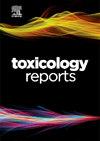Repurposing brucine as a chemopreventive agent in mammary gland carcinoma: Regulating lactate transport through MCT-4
Q1 Environmental Science
引用次数: 0
Abstract
In the present study, we aim to identify a potential drug candidate that targets the Monocarboxylate Transporter-4 (MCT-4) protein. Syrosingopine (SRY) is a well-established inhibitor of lactate transport through MCT-4. We screened 2,11,192 potential leads through ZINC database, which were atleast 50 % structurally similar with SYR. After in-depth analysis, 900 molecules were shortlisted based on Lipinski's rule, optimal molecular weight, binding energy, hydrogen bonding, and ADMET (absorption, distribution, metabolism, excretion, and toxicity) properties that render them viable MCT-4 inhibitors. The outcome underscored Brucine (BRU) as the most promising lead molecule within a cohort of ten potential compounds. BRU is a monoterpenoid indole alkaloid and is used in the regulation of high blood pressure and other comparatively benign cardiac ailments. As such, no reports is available emphasizing the efficacy of BRU on lactate transport or mammary gland carcinoma. BRU demonstrated strong affinity for the MCT-4 transporter's catalytic domain, forming significant hydrophobic and polar interactions with essential amino acids at the binding site. BRU demonstrated significant cytotoxicity and increased the extracellular lactate levels in MCF-7 cells. The findings strongly encouraged BRU's effectiveness, offering promising paths for subsequent investigations.
马钱子碱作为乳腺癌化学预防剂的再利用:通过MCT-4调节乳酸转运。
在目前的研究中,我们的目标是确定一种潜在的靶向单羧酸转运蛋白-4 (MCT-4)的候选药物。Syrosingopine (SRY)是一种公认的通过MCT-4转运乳酸的抑制剂。我们通过ZINC数据库筛选了2,11,192个与SYR结构相似度至少为50% %的潜在引线,经过深入分析,根据Lipinski规则、最佳分子量、结合能、氢键和ADMET(吸收、分布、代谢、排泄和毒性)特性筛选出900个候选分子,使其成为可行的MCT-4抑制剂。这一结果强调了马钱子碱(BRU)是10种潜在化合物中最有前途的先导分子。BRU是一种单萜类吲哚生物碱,用于调节高血压和其他相对良性的心脏疾病。因此,尚无报道强调BRU对乳酸转运或乳腺癌的疗效。BRU对MCT-4转运体的催化结构域具有很强的亲和力,在结合位点与必需氨基酸形成显著的疏水和极性相互作用。BRU显示出显著的细胞毒性,并增加MCF-7细胞的细胞外乳酸水平。这些发现有力地鼓励了BRU的有效性,为后续研究提供了有希望的途径。
本文章由计算机程序翻译,如有差异,请以英文原文为准。
求助全文
约1分钟内获得全文
求助全文
来源期刊

Toxicology Reports
Environmental Science-Health, Toxicology and Mutagenesis
CiteScore
7.60
自引率
0.00%
发文量
228
审稿时长
11 weeks
 求助内容:
求助内容: 应助结果提醒方式:
应助结果提醒方式:


